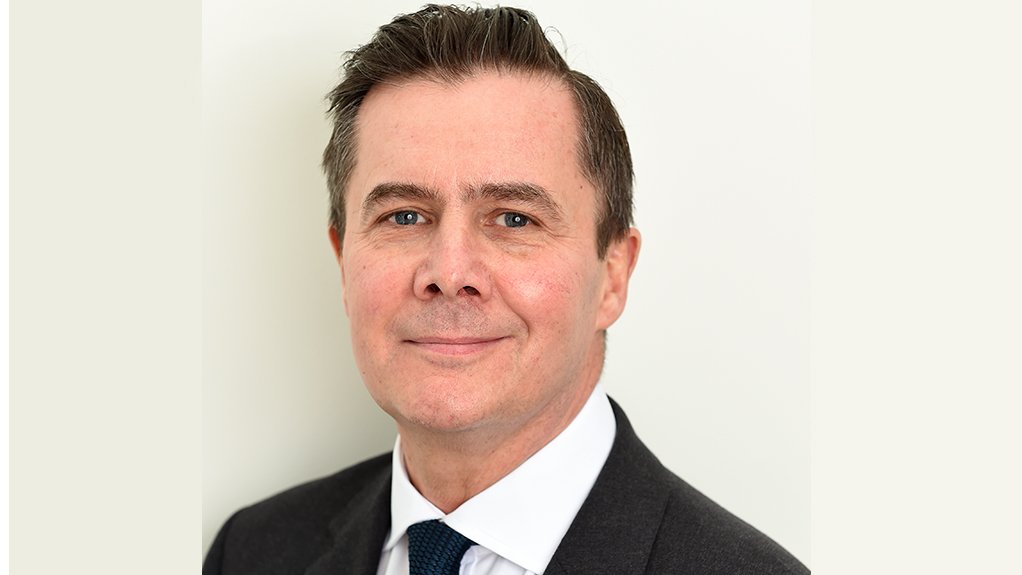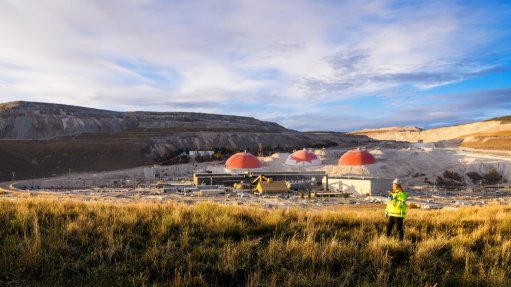Gold mining industry striving to build on sustainability strides


World Gold Council climate change lead and market relations director John Mulligan
Striving for sustainability in every facet of the gold mining industry’s value chain is imperative and while considerable progress has been made in several areas, including responsible practices and reporting, as well as decarbonisation, there is still work to be done in other areas, such as gender parity and bolstering the involvement of junior miners.
This was noted by industry organisation World Gold Council (WGC) climate change lead and market relations director John Mulligan.
Speaking to Mining Weekly from the Investing in African Mining Indaba, in Cape Town, Mulligan averred that the gold mining industry represented by the WGC’s member, had shown “great awareness” of most of the key aspects of sustainability, because investors and local stakeholders had demanded it, while societal expectations for this increasing over the past few years had also played a key driving force.
He emphasised that gold and the gold mining industry had a crucial, two-fold role to play in the just energy transition.
Firstly, while the resource is not part of the basket of critical minerals that many governments identify as key inputs in renewable energy technologies, it certainly has a role to play in facilitating both local decarbonisation and resilience.
Secondly, and importantly, Mulligan highlighted the significant role that gold mining could and had played in actually delivering renewable energy projects, with many companies undertaking projects on or adjacent to their operations.
He cited the example of a large-scale solar plant at Gold Fields’ South Deep gold mine, in South Africa, where the mining sector exerted pressure on the government to change regulation to allow for self-generation of energy.
In the country, investing in renewable energy projects for own generation has allowed mining companies to decarbonise their operations, buffered them somewhat from the impacts of the country’s energy crisis and, as Mulligan pointed out, introduced renewable technologies into areas in the country that may otherwise have been economically unviable.
“Mining companies are therefore able to decarbonise their own operations, while at the same time bringing cleaner energy to remote and rural areas that may not otherwise have had capacity and access,” Mulligan acclaimed, adding that this wasplaying out across the continent as well.
“Gold miners can lay claim to being leaders in having brought renewable energy at an industrial scale to the process and having demonstrated to other parts of the South African economy that it is viable.”
To engender sustainability in other areas of the gold mining value chain, Mulligan pointed out that key for the WGC had been the launch of the Responsible Gold Mining Principles (RGMPs) in 2019.
Compulsory for all WGC members, these are 51 principles and ten overarching principles, which seek to encourage good practice and high standards of performance, across the entire spectrum of responsible business practice.
Mulligan highlighted that this provided tangible proof of responsible mining, as companies had to demonstrate what responsibility meant, and the performance they were designed to encourage was also independently verified.
With the WGC members representing about two-thirds of all global corporate gold mining production, Mulligan asserted that, over the next reporting cycle, a considerable percentage of gold would have been demonstrated to have been produced under transparent conditions in terms of high-quality sustainability responsibility practices.
He informed that reporting began gathering pace last year, after a delay from the pandemic, with about half of the members now reporting full adherence to the cycle.
He also attested to the meticulousness of the RGMPs, with the council undertaking a very “consultative process” in its development – liaising with members about their performance on specific issues, as well as engagements with hundreds of organisations and local communities around the principles and what their aspirations for it were.
The WGC has been engaging with mining investors at the Investing in African Mining Indaba that is currently underway in Cape Town, around the RMGPs, to encourage them to have it as part of their considerations when choosing companies to invest in.
It has also been educating attendees about another area of progress, after the WGC and the London Bullion Market Association convened industry bodies across the world to agree the Gold Industry Declaration of Responsibility and Sustainability Principles, Mulligan highlighted.
This brings together several key participants in the global gold industry who have committed to operating responsibly and sustainably, from mine to market, with the declaration setting out the principles that guide this commitment.
Mulligan described this as “significant”, as it allowed the entire gold value chain to talk to each other.
Meanwhile, central banks continued to remain key buyers of gold owing to it being a risk mitigation asset. The WGC engaged these entities in several ways, including a central bank training programme which included an environmental, social and governance component, Mulligan informed.
Moreover, the WGC engages with central banks to try and encourage them to be positive actors in the buying of artisanal small-scale gold mining, with the aim of having this support engender better practices in this particular industry.
The WGC has also engaged individual central banks on the social and environmental impacts of their reserve assets, with awareness around this increasing.
The WGC is further undertaking collaborative work with the World Bank to address artisanal and illegal mining, and is engaging with this entity to define what good practice looks like.
The latter is leveraging its global presence to encourage government perspectives to be brought to the table, while the former is tapping into the support of its members as such artisanal mining often happens adjacent to their operations.
Mulligan pointed out that this issue required long-term commitments, as well as both global and local solutions, given that each mining jurisdiction was different.
AREAS FOR IMPROVEMENT
Mulligan mentioned an area that needed more work was ensuring that junior miners were brought along in the reporting process, with this culture already entrenched in midtier and major mining companies.
Therefore, he called for sustainability to be embedded into projects from the onset of exploration.
Another area of focus needed to be improving gender parity, with this being a challenge for the entire mining sector. While the gold mining industry was slightly ahead of the average, it still had a long way to go, Mulligan emphasised.
He mentioned that there was also a rising awareness of the need to be committed to preserving nature in a more detailed way, with more progress anticipated on this in the coming years. The WGC was actively pursuing this at present, and considerable data from the gold mining community had already been garnered, Mulligan said.
In a similar vein to the RMGPs, smaller mining companies are lagging and need to be brought along on this process as well.
EFFECTING BROADER CHANGE
On a global level, Mulligan said instability and uncertainty were major impediments to furthering the sustainability agenda, as this made it difficult to commit to strategic, structural, long-term change.
“At a very high level, sustainability will be challenged if there are no long-term commitments from both the public and private sectors,” Mulligan warned.
He highlighted the need to accelerate the climate agenda considerably, with a concerning gap in reaching the United Nation’s Sustainable Development Goals, and also cautioned against a “business as usual” approach.
Mulligan added that mineral-rich economies could adopt a leapfrog approach, capitalising on the growth opportunities from these endowments while simultaneously using them to further sustainability goals.
“There is huge opportunity for economic growth and socio-economic development in ways that really haven’t been seen before, because of dependency and legacy issues.”
In the vein of effecting change at a high level, the WGC attends forums like the yearly Conference of the Parties (COP) to the United Nations Framework Convention on Climate Change, to engage with large institutional investors and their intermediaries and advisers, as well as stakeholders operating in the policy space.
Mulligan explained that these were the entities the WGC perceived to be driving the climate agenda, with governments lagging behind.
He pointed out that the mining sector had been fairly quiet at the past few COPs, and needed to be more ambitious in engaging and telling its story.
For example, there were considerable discussions around critical minerals at COP28 last year, with an acknowledgement that more mining was needed. However, there was insufficient clarity on what this meant in practice, and whether the shifts in capital that would be needed for the transition would also be reflected in mining investment, Mulligan explained.
He noted that there was still much discomfort around mining, with many seeing it as having solely negative impacts, and the positive ones not highlighted.
This underscored the need for the sector to be more vocal at COP and other forums about its potential as a driver of socioeconomic development, and to engage more around the catalytic role it could play in the transition, as the gold industry did in terms of renewable energy, Mulligan averred.
One alternative method that the WGC recently undertook to showcase gold’s full story was the release of ‘Gold: A Journey with Idris Elba’, a documentary created in partnership with Pioneer Productions.
In the documentary, gold’s relationship with sustainability and its influence on this is one of the themes explored by movie star Elba. He also delves into the history of gold, as well as the relationships and impacts engendered from this precious metal – spanning from beauty, to health, community, power, technology and financial security.
Mulligan said that the documentary had piqued interest in the commodity and its influence. Moreover, a screening was held in South Africa with academics and non-governmental organisations, who were often sceptical of the industry, with some positive feedback and shifts in opinions noted after the screening.
The documentary is available on YouTube and the WGC’s website.
It followed the release of ‘The Golden Thread’ documentary, which was released in 2021 and which showcased gold’s utility.
Article Enquiry
Email Article
Save Article
Feedback
To advertise email advertising@creamermedia.co.za or click here
Press Office
Announcements
What's On
Subscribe to improve your user experience...
Option 1 (equivalent of R125 a month):
Receive a weekly copy of Creamer Media's Engineering News & Mining Weekly magazine
(print copy for those in South Africa and e-magazine for those outside of South Africa)
Receive daily email newsletters
Access to full search results
Access archive of magazine back copies
Access to Projects in Progress
Access to ONE Research Report of your choice in PDF format
Option 2 (equivalent of R375 a month):
All benefits from Option 1
PLUS
Access to Creamer Media's Research Channel Africa for ALL Research Reports, in PDF format, on various industrial and mining sectors
including Electricity; Water; Energy Transition; Hydrogen; Roads, Rail and Ports; Coal; Gold; Platinum; Battery Metals; etc.
Already a subscriber?
Forgotten your password?
Receive weekly copy of Creamer Media's Engineering News & Mining Weekly magazine (print copy for those in South Africa and e-magazine for those outside of South Africa)
➕
Recieve daily email newsletters
➕
Access to full search results
➕
Access archive of magazine back copies
➕
Access to Projects in Progress
➕
Access to ONE Research Report of your choice in PDF format
RESEARCH CHANNEL AFRICA
R4500 (equivalent of R375 a month)
SUBSCRIBEAll benefits from Option 1
➕
Access to Creamer Media's Research Channel Africa for ALL Research Reports on various industrial and mining sectors, in PDF format, including on:
Electricity
➕
Water
➕
Energy Transition
➕
Hydrogen
➕
Roads, Rail and Ports
➕
Coal
➕
Gold
➕
Platinum
➕
Battery Metals
➕
etc.
Receive all benefits from Option 1 or Option 2 delivered to numerous people at your company
➕
Multiple User names and Passwords for simultaneous log-ins
➕
Intranet integration access to all in your organisation



















